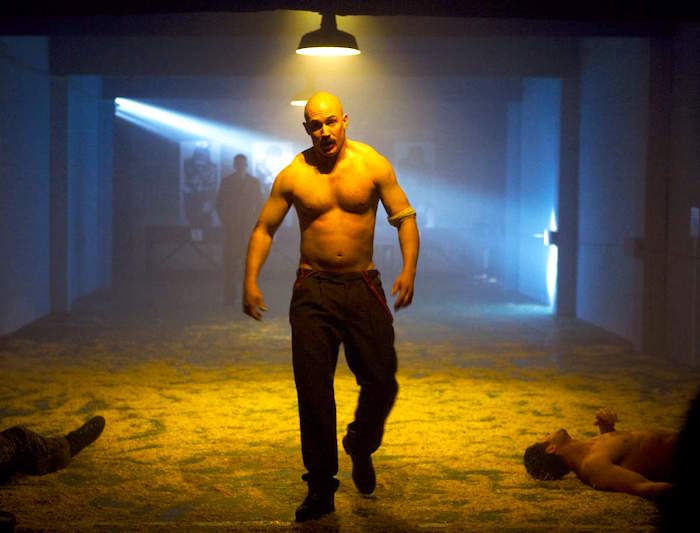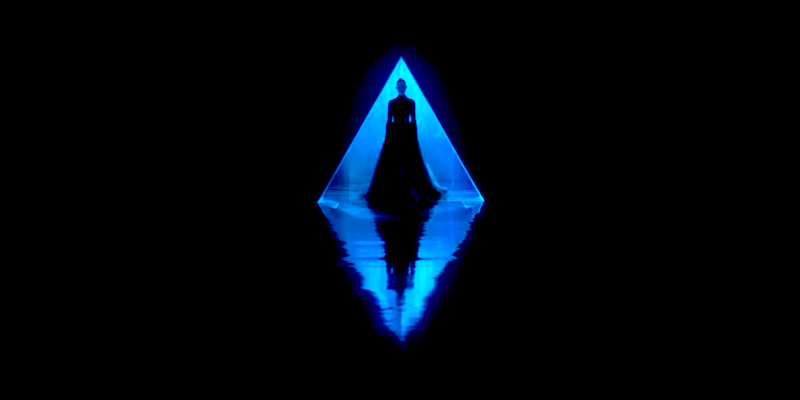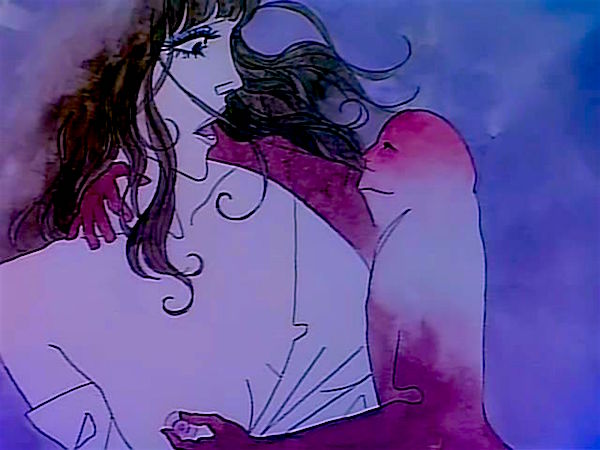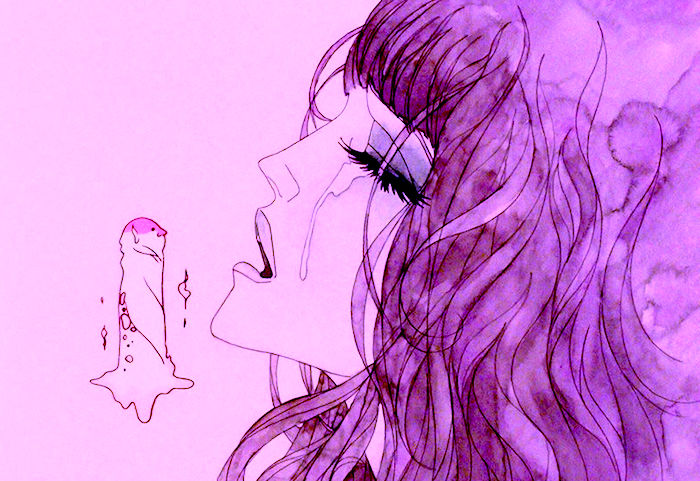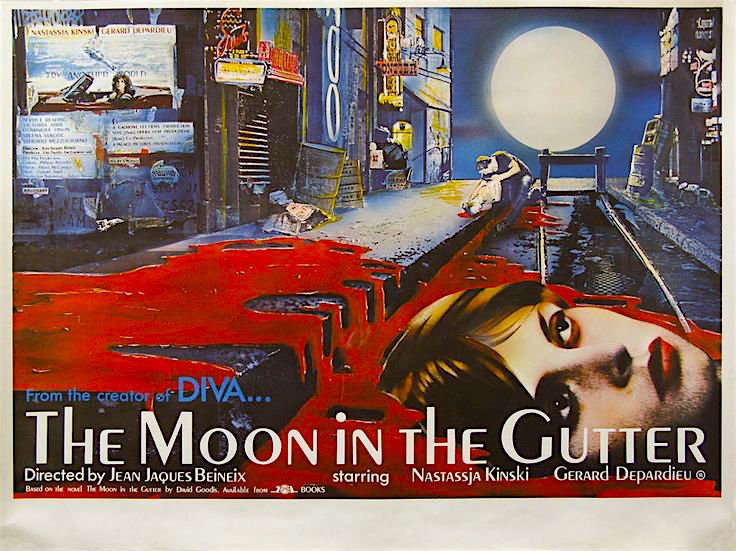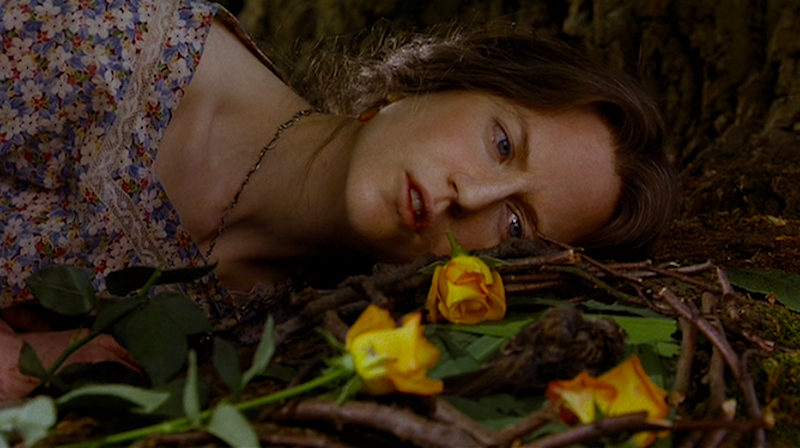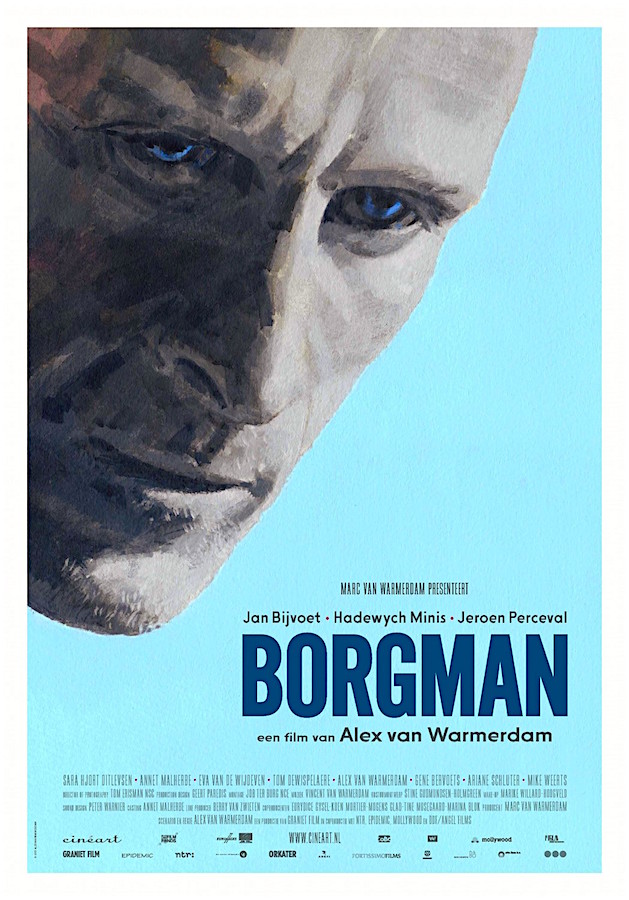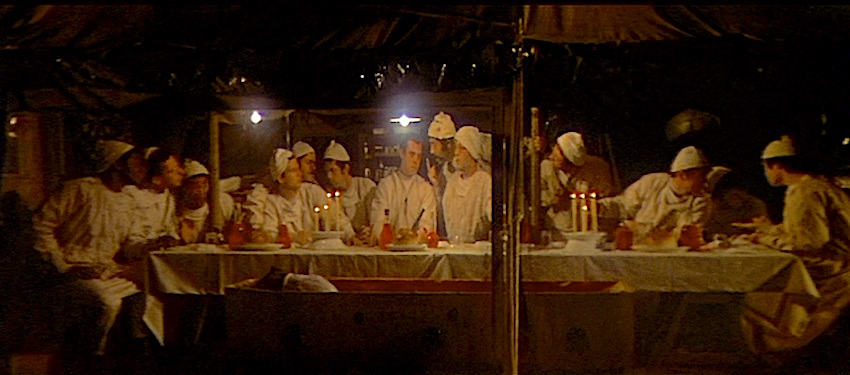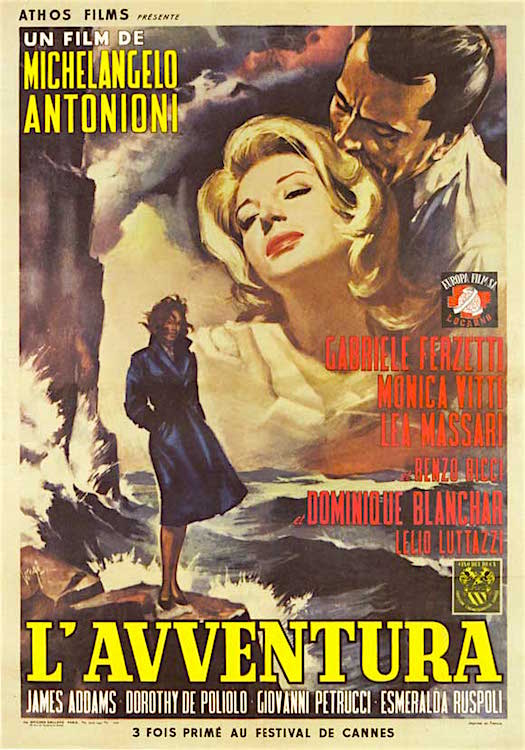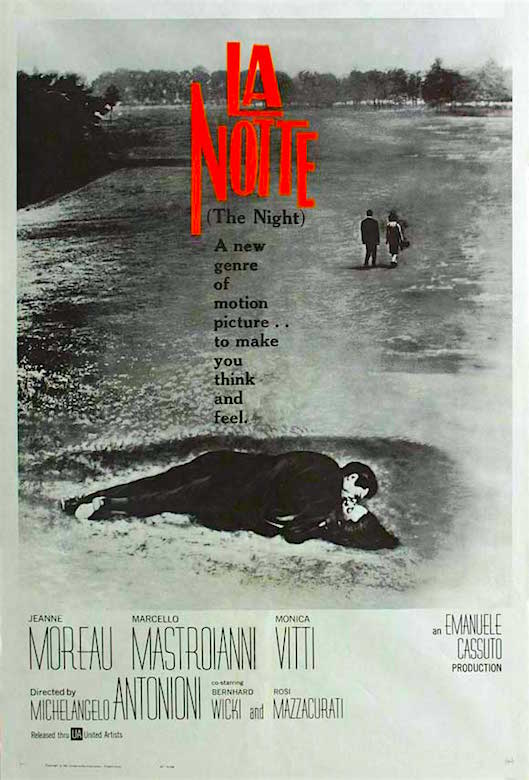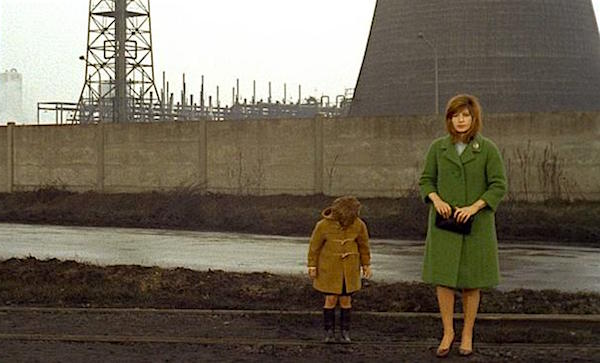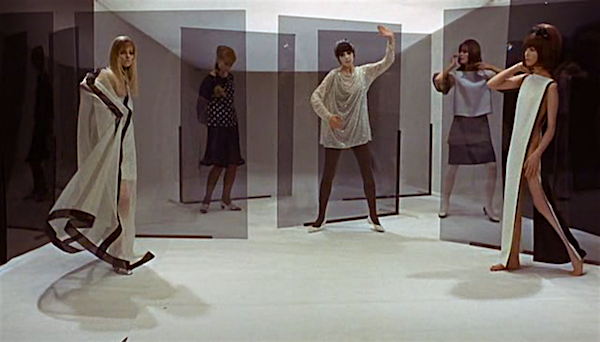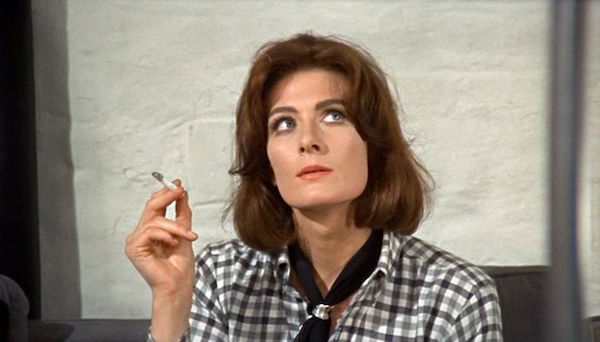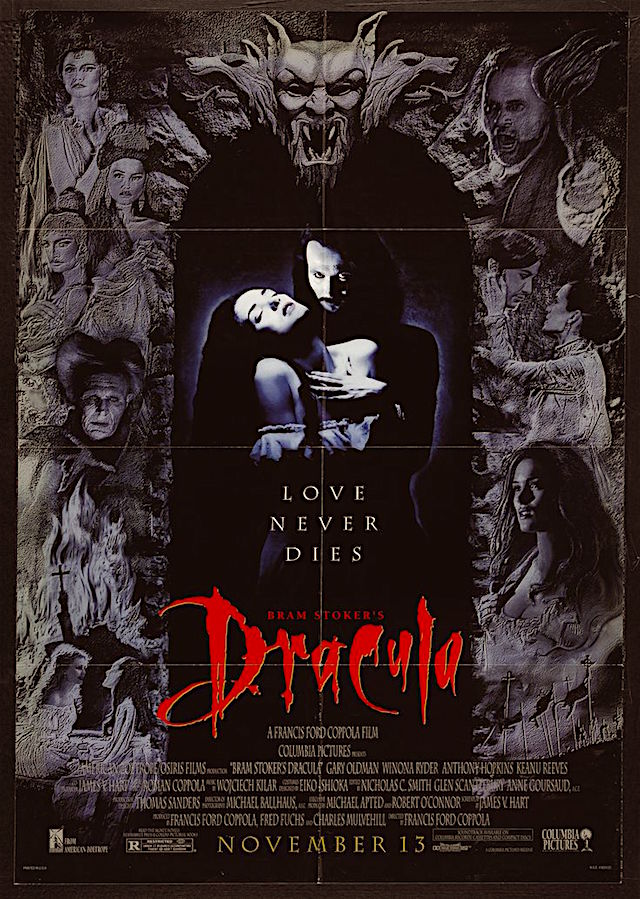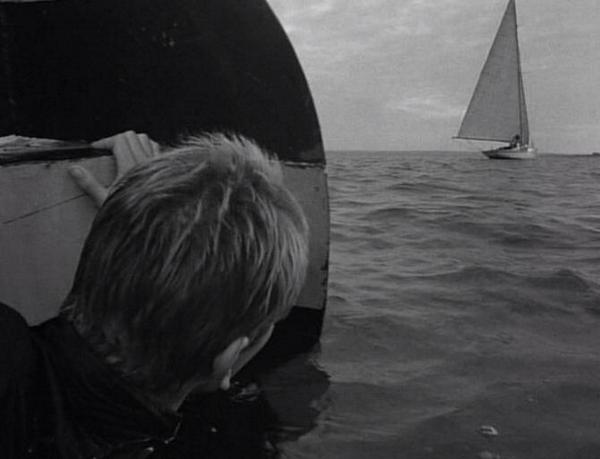
Uh, oh…
Crimes of Passion
Ken Russell, 1984
Cinematography | Dick Bush
I have always hated being told what to do. I prefer to be the boss. My blog is my own as and so are the opinions expressed within it. The odd thing is that I tend to write better when under the pressure to fulfill the needs of another. When left to my own devices my words tend to gather in formation for unorganized tangents or obscure ideas. This challenge continues to plague me. Sometimes I allow my words to flow out and I either attempt to edit / correct myself or I simply delete what has been written. I’ve attempted to write about two Ken Russell films in one post several times.
As he is one of my all-time favorite filmmakers his movies hold themselves as personal time markers in my life. If I’m having trouble remembering what year or when something of note in my life has happened I very often only need to think about when I saw a Ken Russell film. Please note I also love a number of other great filmmakers, but Ken Russell Movies serve as folded pages in my personal history journal. Robert Altman and Claude Chabrol do not connect to my life tracking in the same way.
You see? There! It just happened again!

This variation of Norman Bates has paid the ticket price, but the fact that he snorts poppers and whispers to himself as he watches is more than a little worrying…
Anthony Perkins
Crimes of Passion
Ken Russell, 1984
Cinematography | Dick Bush
All I really needed to write was that I am somewhat passionate about the work of Ken Russell. That would have sufficed. Yet the combination of my brain and the corresponding fingers had to type more information than is required.
Ugh! Here they go again — I am not an argumentative person. I prefer logic. It is not unusual to encounter cinephiles and individuals who sometime enjoy an Art House film who become not only dismissive but often upset to discover that three is a Ken Russell film fan sharing breathing space. I’ve always expected opposition to the art I love. I will only discuss my defense of Ken Russell if asked or pushed into an intellectual corner. For the record, I’ve been pushed into that corner more times than I can count. As I get older I care less about what others think of me. Not too long ago a pal pointed out that I had failed to not only speak up to defend my opinion related to both Andrzej Zulawski and Ken Russell.

Were you expecting restraint or restraints?
Kathleen Turner fully utilizes a night stick to the delight of a cop/client, Randall Brady. This scene was cut for US release, but returned in place for the unrated video release.
Crimes of Passion
Ken Russell, 1984
Cinematography | Dick Bush
At that moment my response seemed perfectly logical to me: Why should I waste my time to try and bend favor from another who felt it appropriate to take a pseudo-intellectual stab at two of my beloved film artists?
It seemed to me that no matter the reasoning, this would have been a waste of my energy.
My pal would have much preferred a potentially unpleasant film theory debate. My response to this individual’s dismissive comment had been, “Well the audience tends to either love or hate artists like Zulawski and Russell. I understand why you might not agree with me.” For my pal, this was a defeatist way of handling a rude comment. Perhaps it was, but the truth is that it is rare for artists as impassioned, expressive and unique as these two to illicit a middle ground response. The very nature of their respective works aim to force a response. These two were Cinematic visionaries who fought against an industry that often tried to reign them in to conform to what would have been compromises.
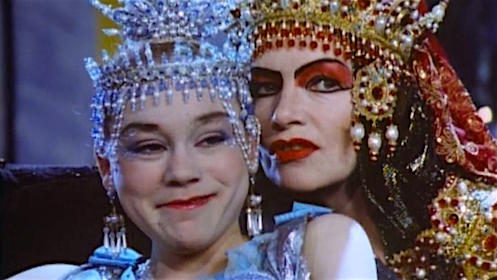
No worries. It’s just some mother observations to her daughter…
Imogen Millais-Scott and Glenda Jackson
Salome’s Last Dance
Ken Russell, 1988
Cinematography | Harvey Harrison
See? I didn’t need to inform any person who might be reading my blog any of that. I just rapt my fingers with a book, but they continue for want of following my often mis-wired brain despite logic’s protest.
But seriously why would I want to see D.H. Lawrence given a Masterpiece Theatre approach? Why would I rather look just at the scenery and listen to a British actor read snippets from a once forbidden novel? I’d much rather watch Glenda Jackson face and dance down free-roaming cattle of Scottish longhorn cows. Or watch Alan Bates seductively and almost pornographically dissect and consume a fig. Why would I want to see Oliver Reed and Bates chat their hidden desires when I can watch them strip naked and literally wrestle the other into submission? Isn’t that what Merchant and Ivory were for?

It’s quite lovely. A bit of male nudity in a rather polite critique of early 20th Century English Society…
Rupert Graves
A Room With A View
James Ivory, 1985
Oh man. Blah, blah, blah. My fingers will not be restricted as easily as my tongue.
What I want to discuss are two Ken Russell films that were made in the 1980’s when Russell’s options with major studios had come to a close. These options closed not so much as a result of disdain for Mr. Russell, but Mr. Russell’s disdain for the industry majors.
I’ve discussed this with both my brain and my fingers and I think we have all reached an agreement: I will write a bit about each film. I will try to avoid losing myself in meandering thoughts.
My hope is that if you’re reading my blog and have never seen either of these two films that you might actually think about checking them out.

“A lady of the night, a man of the cloth. and a passion worth killing for!”
Crimes of Passion
Ken Russell, 1984
1984’s Crimes of Passion was born of anger. Screenwriter, Barry Sandler, had finally managed to get a screenplay he cared about produced. Making Love was a bold film for it’s time. The idea of presenting a romantic love story between two men who were not somehow psychotic or dangerous was a whole new idea for Hollywood. By the time Making Love was released the world of sexuality was about to slip from a revolution directly into of all-consuming danger. Conceived and made before AIDS changed everything but release just as it was about to, the movie failed to do what it intended. An outstanding Activist and a sex positive artist walked away from the experience of Making Love ‘s failure and the hypocritical Hollywood viewpoint to write a scathing satire called Crimes of Passion. Fresh from losing a battle to adapt/create an innovative and good film version of Evita to the big screen, Ken Russell was looking for a new project. After battling against unimaginative and Hollywood/Broadway suits, it is easy to imagine Ken Russell hugging Sandler’s screenplay.
I’ve no idea how many times I’ve seen this highly entertaining and crude comical satire on everything from Identity, Marriage, Religion and most of all — Sexuality. I stopped counting a long time ago.

“It is truly an honor to be named Miss. Liberty 1984!”
Kathleen Turner
Crimes of Passion
Ken Russell, 1984
Cinematography | Dick Bush
If you are easily offended by crass humor or graphic sexuality, this will not be your movie. But if up for the envelope-pushing fun, this movie will not disappoint. Tongue planted firmly in cheek, Ken Russell’s Crimes of Passion is all at once funny, raunchy, rude, eccentric, profane, politically incorrect, unapologetically erotic, surprisingly suspenseful, unhinged and neon-drenched — This is surreal romp that entertains and shocks from beginning to end. Russell had no fear of shock or of being camp. The shocks and camp are not only intended, they are celebrated. Anthony Perkins was more than game to poke fun at his “Norman Bates” role with precision. But make no mistake, this movie belongs to Kathleen Turner.

“Is this a cruise missile or a Pershing?”
Kathleen Turner as China Blue inspecting The Dildo of Death.
Crimes of Passion
Ken Russell, 1984
Cinematography | Dick Bush
Turner’s participation in this film caused jaws to drop, but that reaction seems odd. It is very easy to understand why Kathleen Turner embraced the opportunity to play both Joanna Crane and China Blue. Aside from the fact that these two roles in one offered her a chance to act her ass off — it offered her the unique opportunity to demonstrate what she did best. This was Ms. Turner before the tragic illness of rheumatoid arthritis would force her into pause mode. In 1983 it seemed that the cinematic world was about to be hers. In fact she was at the very top of the A List, but she was in many ways imprisoned by an industry caught in contradictory conflict. From 1980 to 1981 everything changed within the world of Hollywood Cinema. She was an instant and well deserved movie star after she not only pulled off playing Lawrence Kasdan’s Femme Fatale in Body Heat — she owned the role.

“Save your soul, whore!”
“Save your money, shithead.”
Kathleen Turner grows bored with a John.
Crimes of Passion
Ken Russell, 1984
Cinematography | Dick Bush
Although widely praised, Kathleen Turner never quite fit into the 1980’s Hollywood Era. Turner had the skills to be as naturalistic and real as any Actors Studio graduate, but she also conveyed the sort of charisma and on-screen presence more easily aligned with the great stars of the 1940’s cinematic era. It always seemed that when a film offered her the chance to fully utilize her considerable skills something else within the movie would let her down. It is actually rather comical to realize that Geena Davis received more praise for The Accidental Tourist. In retrospect it is Turner who steals that movie. Kathleen Turner does not perform in half-measure. This was largely lost on 1980’s filmmakers and their industry of the day.

“Sorry. I never forget a face. Especially if I’ve sat on it.”
Kathleen Turner blowing bubbles
Crimes of Passion
Ken Russell, 1984
Cinematography | Dick Bush
It was not lost with Ken Russell and she knew that. Ms. Turner took a good deal of crap for taking on the lead role in Crimes of Passion, but she has always stood by the film. This was one of many key gifts of Ken Russell. He actually knew how to fully utilize his actors. Glenda Jackson and Vanessa Redgrave could not fail in any role, but under his direction they were both challenged and inspired. Jackson could not get by with her natural witty charm — for Russell she always had to dig just a bit deeper. As for Redgrave, her interesting reading of character mixed with often odd little mannerisms or ticks was given full flight in The Devils. As for Oliver Reed — no director ever captured his presence and talent as well as Ken Russell.
But the example that most like struck someone like Kathleen Turner was Ann-Margret got away with in Tommy. Ann-Margret is not short of talent, but what she excelled at was interplaying an undeniable erotic energy tempered by a magically conveyed sense that she was nobody’s object. This really seemed like the girl next door who would marry but still go for broke in the bedroom.

And millions of men melted while millions of women wished they could be this sexy without actually being bad…
Ann-Margret
Bye Bye Birdie
George Sidney, 1963
George Sidney really didn’t do much in bringing Bye Bye Birdie to the screen, but he got one thing very right. The idea of putting Ann-Margret in front of a bright blue backdrop which she sang and moved in a hard bit of tease and bait was genius! This was the Sex Kitten personified! It would take almost a decade before Mike Nichols would give her a part suited to her talent. In 1971’s Carnal Knowledge she actually challenges Jack Nicholson as his needy girlfriend. But it was a supporting role.
When Ken Russell cast her as Nora in Tommy it caused a bit of head scratch. Here was a beautiful young woman who would be playing Roger Daltrey’s mom when they were essentially the same age. But here was a filmmaker offering Ann-Margret the opportunity to do the things she did best: Sing and emote. For Russell, Ann-Margret brought forward that idea of sexuality that fit perfectly into Tommy‘s damaged psyche.

Well, really. It was only a matter of time…
Ann-Margret going the distance.
TOMMY
Ken Russell, 1975
Cinematography | Dick Bush
Tell Ann-Margret to sing and dance while covered in pork-n-beans, chocolate sauce and bubble soap residue — it only takes a minute before she finds a way to hump a phallic pillow with an erotic intensity. This surreal cinematic moment among several other surprisingly potent moments and Ann-Margret became a fully respected movie star with a Best Actress Oscar nomination.
Crimes of Passion and Ken Russell offered a similar opportunity for Kathleen Turner. In this 1984 role she was allowed to do what she did best: everything. As Joanna Crane she could play the realism of torment, sexual repression, loneliness and fear.

Joanna Crane: The repressed reality hiding within the surrealism…
Kathleen Turner
Crimes of Passion
Ken Russell, 1984
Cinematography | Dick Bush
As China Blue she could go full throttle movie star. The role would require her to be erotic, funny, sad, transgressive, daring, bold and most importantly it allowed her to explore the full range of human emotion. At last she would be on a screen big enough to capture her talent and beauty. Kathleen Turner delivered a masterful display of performances and Russell framed them exquisitely.
Unfortunately, the world of 1980’s new conservatism was not a welcomed place for a movie like Crimes of Passion. In the 1980’s graphic sexuality was allowed. Or, rather, it was allowed to a certain point. Crimes of Passion moved well beyond that point. It also pushed against the most stringent rule of the era — wild sexual abandon had to come at a price. The 1980’s sexually unrestricted character had to pay some moralistic price for indiscretion. Not to give too much away, the sexual pleasures in Crimes of Passion are not penalized. In fact, they are actually rewarded. That was a big “NO! NO!” in 1984. This was no longer the 1970’s.
This was a Regan and Thatcher world.
China Blue was not welcomed in it. For release in the US, Russell was required to make cuts in order to secure an R Rating. Even then, more than a few cinemas closed the film after the first day or two. This was especially true where I lived: The American Bible Belt.

These heels draw blood…
Crimes of Passion
Ken Russell, 1984
Cinematography | Dick Bush
Wait! My brain and fingers did it again! Damn!
Look, Crimes of Passion has been largely lost on the shelf of Cult Cinema for far too long. Sure, it is a Cult Film — but it is a great deal more as well. Just half an hour into this film and you will note its influence in modern cinema. Crimes of Passion is Neon-Noir. It is also hopelessly entertaining and very artistic. Dick Bush’s cinematography is excellent. Stephen Marsh’s production design is really quite brilliant. Rick Wakeman’s synth score is interestingly current. In fact, FOX TV’s American Horror Story owes a good deal to many aspects of this movie. It has been and continues to be influential.

“Don’t fight me, child. I’m the messenger of God and I only want to heal you!”
Anthony Perkins gets more than he bargained for…
Crimes of Passion
Ken Russell, 1984
Cinematography | Dick Bush
The UK’s Arrow Video has secured all the licensing rights, has restored and will be releasing Crimes of Passion to DVD/Blu-Ray this coming July. Finally a new generation will be able to enjoy this twisted bit of cinematic magic!
Arrow Video Presents Crimes of Passion

Crimes of Passion
Arrow Video
Art Design by Twins of Evil
This is a film that has never received the praise it deserves. It most likely never will, but for those of us smart enough to recognize it — Crimes of Passion is a film of complex and rude brilliance. Although it failed to please the majority of film critics and was a cinematic flop, the film did yield some return via the VHS market. I am sure Mr. Russell would have been much happier had the movie had performed better, he was not one to give up. It is key to note that Ken Russell always got the joke. He also made the film he set out to make.
Man! I did again — meandering about and ranting to the choir. If you’re reading this you are interested and I do not need to point these things out to you. Anyway, there is that second Ken Russell movie I want to discuss. Let’s see if I can restrain myself with more success.

O, Salome! Is that a banana you’re eating or are you pinning for something a bit more…
Salome’s Last Dance
Ken Russell, 1988
It would not be true to write that I needed an excuse to cut school. I hated being told I had to be “present” every school day. I skipped school often. However it was unusual for me to call in “sick” to work. But I was so excited to discover that Ken Russell’s latest movie was actually playing at a cinema in Houston that I did both. I remember worrying that my shitmoblie might fail me on the drive there. Worse yet, I wasn’t sure I had enough money to make it back home. But it was worth the risk. Salome’s Last Dance was playing at a cinema located in the heart of what was then known as the gay section of Houston.
Fran Leibowitz has noted that while AIDS stole far too many great artists — it did something actually just as if not more devastating to the arts — it stole the best persons of the audience.
It was a very hot and humid day in Southeast Texas, but it was freezing in that cinema. Wearing shorts and a torn OP shirt, I was wanting for a coat. I was alone in the theatre until three men entered. All three of them were emaciated-looking and clearly quite ill. They sat a few rows in front of me. Once the movie started it was clear that these three men were clever enough to allow their literary knowledge to serve as an instrument to fully appreciate Ken Russell’s jokes vs being offended.

Caged and about to get a rough poke…
Douglas Hodge
Salome’s Last Dance
Ken Russell, 1988
Cinematography | Harvey Harrison
As the miserable and insufferable Bosey is being tormented by half nude Amazonian dominatrix guards, these three audience members got the giggles. I laughed as well, though I was really puzzled by the spears with which they threatened Douglas Hodge’s Bosey. What were those fist things that were covering sharp tips? I was yet “mature” enough to know about dildo fisting toys.

Several queens form The Nazareans . As well as the late Imogene Claire.
Salome’s Last Dance
Ken Russell, 1988
Cinematography | Harvey Harrison
When the head dominatrix shoves the fisting spear up Bosey‘s ass the three men fell into hysterics. Almost immediately after Bosey‘s little surprise, Ken Russell made his cameo entrance as a brothel photographer capturing Bosey/John The Baptist‘s torment with his camera. I’ve never really seen Russell’s cameo as Hitchcockian so much as I think they served more as naughty wink. As if to indicate the silliness of the filmmaker putting himself in a movie should serve as more of a cinematic jester. I could be wrong on that, but these three gay dudes totally “got” this movie and they loved every minute. Every snarky innuendo and every time Glenda Jackson hammed a line up, they chortled in glee. I understood the literary references and caught the camp, but some of the more adult ideas most likely escaped me.
I remember making a mental note that I really had to get my ass out of Texas as soon as I graduated from university. I mean, only three people in a cinema to see a Ken Russell movie?!!?
The same had happened when I saw David Lynch’s Blue Velvet a couple of years earlier.

“I will kiss your lips, John the Baptist!”
Douglas Hodge and Imogen Millais-Scott
Salome’s Last Dance
Ken Russell, 1988
Cinematography | Harvey Harrison
Wait. I’ve done it again. I’ve lost myself and allowed my prose to wander off into a memory tangent. O my brain and fingers! Why do you fail me?!?
Salome’s Last Dance came into being thanks to a deal Russell had secured with Vestron after he made Gothic. He had some freedom, but his hands were tied when it came to the budget. He had to bring the movie in for under $1,000,000. About $200,000 under that million dollar mark. Ken Russell was a filmmaker who drew his own path in cinema. And he never had a problem with coloring along as he drew. But he certainly wasn’t always going to color within the conventional lines. By 1987 his abilities to secure the kind of financing his films deserved were gone. The master filmmaker carried on and simply improvised.

Sitting just outside “the well” or, um, the dumbwaiter to listen to John The Baptist’s rants…
Salome’s Last Dance
Ken Russell, 1988
Cinematography | Harvey Harrison
After managing to find a way to turn Paddy Chayefsky’s overtly cerebral and ultra-thick dialogue into a watchable film, Altered States — Russell had no patience for Hollywood studios. They certainly had no patience for him. In the 1980’s he made several odd movies. Only one of these received any amount of critical praise. The Rainbow would be Mr. Russell’s final film that even slightly approached a standard or conventional narrative. It approached it very well, but at the time I remember thinking that The Rainbow lacked the sparks of innovation I had grown to love, but it appealed to a larger audience. Looking at it now, The Rainbow is a solid and polished film. But pales in comparison to Russell’s more experimental and twisted films of this era. Over the years Crimes of Passion, Gothic, and The Liar of the White Worm have secured Salome’s Last Dance valued Cult Film status. There is certainly nothing wrong with being labeled a Cult Film, but some 20 to 30 years later — a couple of these movies reveal something far more than they did when first released. This is particularly true of both Crimes of Passion and Salome’s Last Dance.

Glenda Jackson takes a well-earned smoke break…
Salome’s Last Dance
Ken Russell, 1988
Cinematography | Harvey Harrison
Salome’s Last Dance ‘s strange play-within-a-film has aged brilliantly. As Ebert noted in 1988, a low budget did not prevent Ken Russell from securing top noted artists both in front and behind the camera. The production design is both realistic and surrealistic in equal measure. It is also lush, erotic, witty, profane and “Wilde-ly” entertaining.
Russell does not change Oscar Wilde’s play. Instead he constructed a way to offer some perspective on just how bold, daring and witty Wilde truly was. He also finds creative and clever ways to tie Oscar Wilde’s tragic personal life tied directly to the action of his Salome play. The film’s plot involves a surprise performance of Wilde’s play with the playwright as the only audience member. Russell bends history a bit to also tie this odd fictional staging to coincide with the arrest that would ruin the great writer’s life.

Glenda Jackson and Stratford Johns having a lot of fun and bringing it all to life…
Salome’s Last Dance
Ken Russell, 1988
Cinematography | Harvey Harrison
Heading up Russell’s cast is the always brilliant Glenda Jackson, Nickolas Grace and Stratford Johns. Russell cast an unknown to play the brothel maid who is plays Salome. Imogen Millais Scott was quite an amazing discovery. She quite literally manages to steal the movie away from Jackson. This in of itself is a masterful feat! Salome’s Last Dance would be Scott’s only film. The talented actress had caught a dangerous virus and lost her eyesight just before filming was to begin. To his credit, Ken Russell refused the idea of replacing her. While this might have been an act of kindness, it was a very wise decision. Imogen Millais Scott bites into each word with a demonic bratty precision. Ms. Scott’s performance is off-kilter brilliant. It is hard to know exactly, but there is something truly disturbing about the way Salome directs her eyes. Imogen Millais Scott had an unusual look about her anyway. She looks at once like a little girl and other times like someone far older. I find it difficult to articulate why, but this actress has a rather disorienting appearance. The role itself is perverse, but there is something uncomfortably disarming regarding her individual carriage. This Salome is envisioned as a Lolita gone to seed.

Uh, oh. Herod is boring Salome…
Salome’s Last Dance
Ken Russell, 1988
Cinematography | Harvey Harrison
The brothel workers and customers perform the play with rabid energy. Michael Arrals’ created costumes that were both period and wonky/cheesy BDSM. The production is decidedly kinky and perverse. As the film’s concept dictates, the largely male brothel goes for broke which allows Russell to amp up the erotic subtext of the play itself. Every member of Herod’s court is sexualized beyond belief. It seems as if Ken Russell called Central Casting London and asked for 15 British Nasties wanna-be’s. These ladies are not great actors, but they are not meant to be. It works effortlessly.
The concept of metanarrative is fleshed out in more ways than one. As Oscar Wilde watches his play once intended for Sarah Bernhardt but banned by the British government is now presented by sex workers and their customers. Russell is playing off real-life tragedy. By the time this film reaches the mid-point, the reality of the film’s “audience” and those “acting” on stage have already interlaced. Wilde’s play takes on additional meanings of transgression and emotional betrayals. Bosey is playing John The Baptist which takes on the inference that it will soon be Wilde being tortured in prison while Salome’s dance should have been performed by Bosey. And here we are watching the play with Oscar Wilde himself.

Stratford Johns and Imogen Millais-Scott
Salome’s Last Dance
Ken Russell, 1988
Cinematography | Harvey Harrison
The result is an avant-garde and Surrealist film that never loses its energy or the viewer’s interest. Considering that none of Wilde’s original play has actually been altered, it is a bit of cinematic genius that this film is so nasty and darkly comical. Russell’s staging of Salome’s Dance of the Seven Veils is spectacular and more than a little surprising. Gender is up for grabs. It has to be seen to appreciate the audacity. If you are familiar with British Literature and Oscar Wilde, you already know that this dance was an essential plot point and key to the general theme of the play. So it is somehow fitting that Ken Russell has found a whole new way to bring this dance to life — and with some new meaning. These shifts in meanings and the use of perverse comedy are Russell’s own imaginings — yet they fit Wilde’s play like a lubed up latex glove. Harvey Harrison’s cinematography is exceptional and the costumes are only rivaled by Michael Buchanan’s production design and Christopher Hobbs set work. The brothel’s perverse take on Salome is intended to look cheep and crass, but Russell still finds ways to often make it all look spectacularly lush. In place of a musical score, Russell wisely choose various pieces from the realm of public domain and was lucky enough to have use of the London Philharmonic Orchestra to fill the soundtrack of the movie.

But did you enjoy our little play?
Nickolas Grace, Glenda Jackson and Stratford Johns
Salome’s Last Dance
Ken Russell, 1988
Cinematography | Harvey Harrison
Glenda Jackson is at her comedic best. It is clear that the great actress is having fun as both Herodias and Lady Alice. Stratford Johns is particularly invested in his performances as both Herod and Alfred Taylor. Like Jackson, he is clearly having fun, both actors are so shrewdly funny it is hard to take your eyes off them. It’s all a lot of fun, but both Jackson and Johns are able to turn it on a dime. The ultimate joke of the film is the absolute cruelty of what we have just seen. Wilde’s play ends with a thud, but Russell’s film manages to find a louder one. Innovative, hilarious, perverse, intelligent and stunning to behold — Ken Russell’s Salome’s Last Dance could have easily been made yesterday. It feels current.
This is more than a Cult Film. Salome’s Last Dance is cinematic art. The problem is that Ken Russell was about two decades ahead his time. Certainly not a conventional film and most likely not a movie for your grandparents — This is one film that deserves a new viewing and reassessment. It is currently available via US iTunes. The quality is not quite up to par with the now out of print DVD, but it is strong enough to see the magic that Ken Russell created with almost no money but a great deal of skill, imagination and limitless artistic abilities. It is more likely that we will see Gothic and The Lair of the White Worm restored before Salome gets a proper platform on which to dance.

Ready for her kiss…
Salome’s Last Dance
Ken Russell, 1988
Cinematography | Harvey Harrison
But at least her final dance can still be seen. There is some magic there and Ken Russell’s visionary work refuses to be silenced. Thank goodness.
matty stanfield, 4.15.2016























